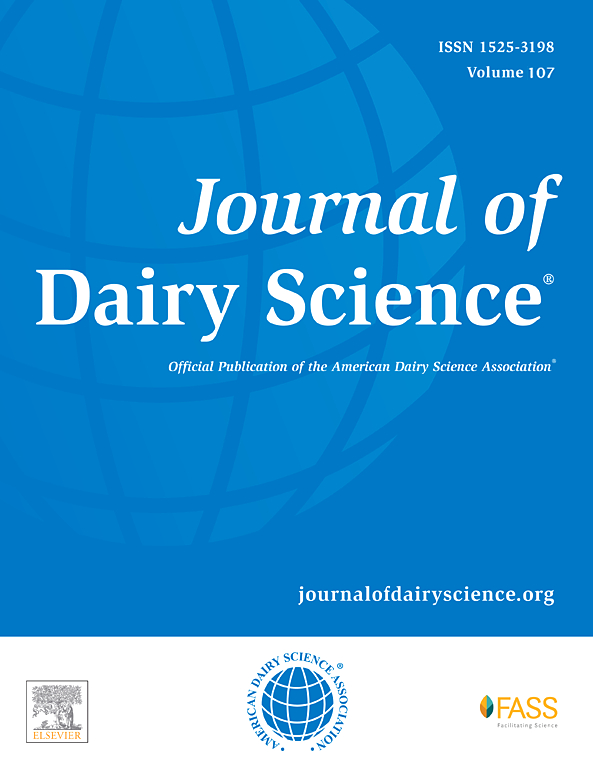Milk adulteration identification using hyperspectral imaging and machine learning
IF 3.7
1区 农林科学
Q1 AGRICULTURE, DAIRY & ANIMAL SCIENCE
引用次数: 0
Abstract
Milk adulteration poses a global concern, with developing countries facing higher risks due to unsatisfactory monitoring systems and policies. Surprisingly, this common issue has often been overlooked in many countries. Contrary to popular belief, adulterants in milk can result in severe health risks, potentially leading to fatal diseases. Detecting and categorizing milk adulteration is crucial for consumer safety and the dairy industry. This research is divided into 2 breakthroughs, destructive and nondestructive methods. In the destructive method, the Lactoscan system was used for qualitative analysis: SNF, density, fat, lactose, conductivity, solids, protein, temperature, and pH level. The research also examines nondistractive hyperspectral imaging (HSI) through HSI Specim Fx-10 (397–1,003 nm; Specim, Spectral Imaging Ltd., Oulu, Finland) analysis to detect various phases of milk adulteration for accurate and user-friendly imaging-based adulterant detection and categorization. Preprocessing involves radiometric correction, image resizing, region of interest selection for feature extraction, and empirical line method to calculate spectral reflectance signature. Machine learning techniques (logistic regression, decision tree, support vector machine, and linear discriminant analysis [LDA]), are employed, with LDA excelling in adulteration identification by learning the spectral signatures. These algorithms are trained and validated using a developed milk adulteration dataset. Training, testing, and validation accuracy, precision, recall, F1 score, kappa, and Matthew's correlation coefficient metrics showcase the effectiveness of the proposed pipeline, outclassing numerous state-of-the-art approaches with a validation accuracy of 100%. In conclusion, this study established a multiclass model capable of detecting milk adulterant behavior, showing significant practical application for milk quality assessment.
利用高光谱成像和 ML 识别牛奶掺假。
牛奶掺假是一个全球关注的问题,由于监测系统和政策不尽人意,发展中国家面临的风险更高。令人惊讶的是,许多国家往往忽视这一常见问题。与人们普遍认为的相反,牛奶中的掺假物质会导致严重的健康风险,有可能引发致命疾病。检测和分类牛奶掺假对消费者安全和乳制品行业至关重要。这项研究分为两个突破口,即破坏性方法和非破坏性方法。在破坏性方法中,使用 Lactoscan 系统进行定性分析:(固体非脂肪(SNF)、密度、脂肪、乳糖、电导率、固体、蛋白质、温度和 pH 值)。研究还通过 HSI Specim Fx-10(397-1003 nm)分析仪对非衍射高光谱成像(HSI)进行了检测,以检测牛奶掺假的各个阶段,从而实现基于成像的掺假物检测和分类的准确性和用户友好性。预处理包括辐射校正、图像大小调整、选择感兴趣区域(ROI)进行特征提取,以及采用经验线法(ELM)计算光谱反射特征。采用了机器学习技术(逻辑回归(LR)、决策树(DT)、支持向量机(SVM)和线性判别分析(LDA)),其中 LDA 通过学习光谱特征在掺假识别方面表现出色。使用开发的牛奶掺假数据集对这些算法进行了训练和验证。训练、测试和验证的准确度、精确度、召回率、F1-分数、Kappa 和马修相关系数 (MCC) 指标显示了所提出的管道的有效性,以 100% 的验证准确度超越了众多最先进的方法。总之,本研究建立了一个能够检测牛奶掺假行为的多类模型,在牛奶质量评估方面显示出重要的实际应用价值。
本文章由计算机程序翻译,如有差异,请以英文原文为准。
求助全文
约1分钟内获得全文
求助全文
来源期刊

Journal of Dairy Science
农林科学-奶制品与动物科学
CiteScore
7.90
自引率
17.10%
发文量
784
审稿时长
4.2 months
期刊介绍:
The official journal of the American Dairy Science Association®, Journal of Dairy Science® (JDS) is the leading peer-reviewed general dairy research journal in the world. JDS readers represent education, industry, and government agencies in more than 70 countries with interests in biochemistry, breeding, economics, engineering, environment, food science, genetics, microbiology, nutrition, pathology, physiology, processing, public health, quality assurance, and sanitation.
 求助内容:
求助内容: 应助结果提醒方式:
应助结果提醒方式:


